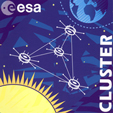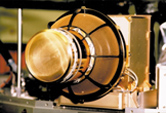|

Fig. 1: Representative ion fluxes encountered along the Cluster orbit in the solar wind (SW), the magnetopause (MP), the magneto sheath (MSH), the plasma mantle (PM), the magnetosphere (MSPH), the plasmasheet (PS), the lobe and upwelling ions (UPW). The range of the different sensitivities of CIS1/CODIF (Low Side, High Side and RPA) and CIS2/HIA (Low Side and High Side) are shown with different colors.
|
|
General
The prime scientific objective of the CIS experiment is the study of the dynamics of magnetized plasma structures in and around the vicinity of the Earth’s magnetosphere, with the determination, as accurately as possible, of the local orientation and the state of motion of the plasma structures required for macrophysics and microphysics studies. The four Cluster spacecraft, with relative separation distances that can be adjusted to spatial scales of the structures (a few hundred kilometers to several thousand kilometers), give for the first time the unambiguous possibility to distinguish spatial from temporal variations. The CIS experiment has been designed to provide substantial contributions to:
- the study of the solar wind/magnetosphere interaction;
- the dynamics of the magnetosphere, including storms, substorms, and aurora;
- the physics of the magnetopause and of the bow shock;
- the polar cusps and the plasmasheet boundary layer dynamics;
- the upstream foreshock and solar wind dynamics;
- the magnetic reconnection and the field-aligned current phenomena
- the study of low energy ionospheric population.
The four Cluster spacecraft encounter ionic plasma with vastly diverse characteristics over the course of one year (Fig.1). In order to study all of the plasma regions with the fluxes shown in Fig. 1, the CIS experiment is designed as a highly versatile plasma experiment with large dynamic range and mass per charge resolution.
|
Bow Shock
The quasi-parallel bow shock is known to be the source of a diffuse energetic ion population and low frequency waves. The recent success with hybrid simulations has demonstrated that the energetic ion and wave activity are necessary ingredients of the shock formation which itself is a high dynamic (or even quasi-cyclic) process. This simulation work has paved the way for a combined in-depth study of the evolution of the ion distributions across the shock and their temporal variation with the CIS instrument. As has been shown in a modeling with simulated spacecraft, a close collaboration between the data analysis and simulations will be needed for this task. It can also be expected that the association of ion density enhancements with magnetic pulses upstream of the shock can be identified with CIS and the multi-spacecraft capabilities of Cluster, as opposed to statistical studies which only yield an average spatial distribution. These new measurements will significantly further our understanding of the wave-particle interactions at the bow shock and their importance for ion acceleration and shock structure.
At the quasi-perpendicular bow shock the specular reflection of ions, their subsequent energy gain in the upstream Vsw x B convection electric field, and their final escape into the downstream region, are known to be important in the dissipation of energy at the shock. The scale length on which the scattering of the original ring distribution and the final thermalization occurs can at best be guessed. With separation distances from a few 100 km to a few 1000 km the vital scales of several ion gyro radii can be covered with the spacecraft configuration.
|
Ionospheric Plasma Outflow in the Polar Regions
Since the discovery of non-thermal O+ ions at magnetospheric altitudes it has been demonstrated that the Earth’s ionosphere acts as a significant source of magnetospheric plasma. The source of free energy that powers dayside outflows is a combination of solar UV radiation and solar wind electromechanical energy. It is well established that solar UV is responsible for long-term modulation, such as over different phases of the solar cycle and in different seasons. On the other hand, numerous case studies reported a good agreement between strong disturbances in the solar wind inputs, such as those associated with the arrival of a coronal mass ejection (CME), and a dramatic enhancement of outflowing ions of ionospheric origin. The CIS plasma analyzer with its capability to determine the plasma composition and to measure the 3D distribution of ions of ionospheric and solar wind origin enables us to study various plasma signatures in the polar magnetosphere (labeled in blue in Fig. 2) and to investigate the plasma sources and outflow mechanisms (labeled in red in Fig. 2), both at intermediate and high altitudes.
|








